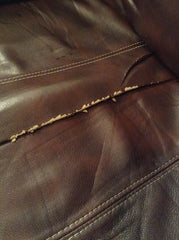About Leather

Urban Rhythm's Melba sofa in semi-aniline leather.
Most people choose leather for their sofa because they believe it’s more durable than fabric and is easier to choose since there are no patterns to consider. Is this right? Yes, and no.
Some people get disappointed when they get their leather sofa home because they made the buying decision based on the wrong expectations.
When we choose leather, we have a desire that it appear flawless, easy to clean like vinyl, but soft and supple. In reality, even the highest quality leather has flaws and natural markings - it's these that give character to your furniture and distinguishes it from the many imitation pieces that flood the market.
The beauty of natural leather is that no two skins are exactly alike, their natural flaws such as scarring or the occasional insect bite mark tell the unique story of each hide. If properly cared for, your furniture will patina and become more supple with age.
When you invest in a genuine leather product from us, you can expect that you'll have a unique piece.
What you need to know about leather
Coverings promoted and sold as leather differ in durability, ease of cleaning, in suppleness and how effectively they can be repaired.

Aniline leather. Image source: www.scanaprima.no
Leather types
Leather is an animal hide that has been highly processed to preserve, soften, beautify and protect the finished product. The great variety of leather available today can usually be put into one of three categories:
Aniline leather
Aniline is the most natural looking leather with the unique surface characteristics of the hide remaining visible. Aniline leather is coloured only with dye and not with a surface coating of polymer and pigment. A light surface coating may be applied to enhance its appearance and offer slight protection against spillages and soiling.
Semi-aniline leather
Semi-aniline is more durable than aniline whilst still retaining a natural appearance. The increased durability is provided by the application of a light surface coating which contains a small amount of pigment. This ensures consistent colour and imparts some stain resistance.
Pigmented Leather
Pigmented leather is the most durable and is used in the majority of furniture upholstery. The durability is provided by a polymer surface coating that contains pigments. The surface coating allows the manufacturer more control over the properties of the leather, e.g. resistance to scuffing or fading. It will also have the most uniform appearance and least natural look as a result.
Types of pigmented leather
Full grain pigmented leather
The grain surface is left intact before applying the surface coating.
Corrected grain pigmented leather
The grain surface is scrubbed to remove imperfections before the surface coating is applied. A decorative grain pattern is then embossed into the surface.
(Indistinguishable from full grain pigmented leather to the naked eye)
Finished split leather
The middle or lower section of a hide with a polymer coating applied and embossed to mimic a grain leather. Finished splits should only be used in low stress applications because they are weaker than grain leather.
(Indistinguishable from full grain pigmented leather to the naked eye)
Antique grain (two-tone or rub-off)
A special surface effect has been created to mimic the unique 'worn' appearance of traditional leathers. This is achieved by applying a contrasting top-coat which is applied unevenly or partially rubbed off to reveal a paler underlying colour.
Pull-up leather (also known as waxy or oily pull-up)
A leather with a natural appearance which lightens in colour when stretched during wear to produce a unique worn-in effect with time.
A word about imitation leather
At the lower end of the sofa market, such as in many imported suites, the sides and backs of sofas are frequently covered with less expensive materials such as splits, bonded leather products or matching vinyl panels. This is done to keep prices down. Be certain of the leather you are looking to buy, as you may not be able to tell the difference by sight alone.
“…not all leather couches are created equal, and sofas made of bonded leather are a prime example of true furniture inequality.”
— consumeraffairs.com
Bonded Leather
Bonded leather is made mostly of blended leather fibres that are glued together (very much like chipboards vs solid timber), then covered with a vinyl top. Bonded leather behaves much like vinyl. Strictly speaking, it is not leather at all.
PU Leather, Pleather, Leatherette, Vegan Leather, Vinyl or PVC
There are various names given for man-made leather-like material, however they are all very similar. PU Leather, Pleather, Leatherette, Vegan Leather, Vinyl or PVC is essentially fabric (natural or synthetic) which is coated in a leather-like PVC layer.
Leather-like Fabric
Made from polyester, there are new fabrics available that mimic the look of leather, without feeling plastic like vinyl.
Imitation Leather can cost you more
Imitation leather is prone to cracking, bubbling and peeling over time, is difficult to mend if damage occurs (replacement upholstery required), and generally does not age well. The sofa pictures below are an example of a bonded leather sofa that has cracked and peeled within a few years of use.


Imitation leather that has started to peel and crack. Image source: ripoffreport.com
Having said that, vinyl and man made leather-like fabric can be effective for small furniture applications such as dining chairs and bar-stools where replacement of a damaged seat cover would be less expensive.
At Urban Rhythm we recommend using only quality genuine leather or quality fabric over imitation leather for sofa coverings.
Where durability is a priority, consider a quality fabric or genuine leather over imitation leather.
When you invest in genuine leather furniture from us, you can rest assured that our craftsmen won’t cut corners: no imitation material will be used.
